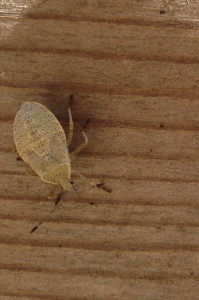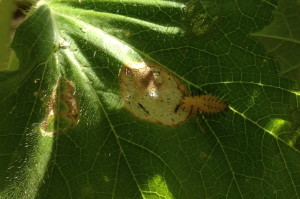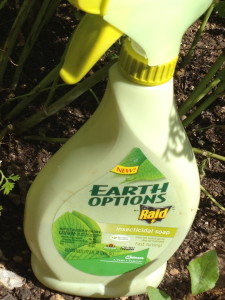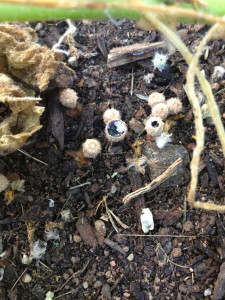How to document and explain your IBS for the best medical care.
Squash Bugs: This Means War!
I had such high hopes for my garden this year. I bought organic cow poop to fertilize it, started with organic plants, learned to trim tomatoes and basil correctly and built a trellis for my squash and cucumbers. I have seen bees happily pollenating my squash blossoms and worms aerating my soil. I thought I was all set. All of the vegetable plants began to blossom and transform into food for my family. I thought my thumb had finally turned green. And then I was attacked. These grey bugs and ugly fuzzy yellow critters began appearing. At first, I thought they were cute – the grey ones were always “getting busy” with each other, so who knew that they would soon become my arch nemeses?
My friend posted a comment on Facebook that her squash plants were dying and she had found evidence of these yellow critters with black spikes. I hadn’t seen those on my plants yet, but I went out to check. Son of a gun, they were there! I read on about what her friends were telling her to do. Most thought it was a lost cause. My initial reaction was, “What harm could such little creatures do?” But within two days, I knew the answer: They killed off all but one of my squash plants.
I did a little research to find out more about these evil creatures. The grey beetles are actually called Squash Bugs and their babies are called Nymphs (I would call the parents nymphs too, seeing how busy they were making babies). They lay copper eggs on the undersides of leaves, which I had seen. The yellow critters are called Beetle Larvae and when they grow up, they are called Squash Beetles. The Squash Beetles look like gigantic lady bugs. I have only seen one of those, so I am hoping that I nipped their growth in the bud.
The information on how to get rid of these creatures could leave a gardener feeling defeated; there is no spray, food, or trap that will easily rid squash plants of them. There were some gardeners who stated that using a soapy solution sprayed on the top and underside of all of the leaves helped. I bought one recommended for organic gardening and went out to spray. I covered as many leaves that I could reach. Quickly, the solution dwindled, so I left it at that and would check back in the morning. When I saw those horny bugs going at it again, I knew the soap didn’t phase them. Back to the drawing board. From further research, I found that the soap would kill the nymphs, but the grey Squash Bugs and the larvae would have to be killed by hand… squishing them. Not my favorite pastime. I decided to make my own soap solution (1 quart water to 1 teaspoon of dish soap) and reused the squirt bottle that I had bought. I had to do what I had to do. This was now war! I went into Mama Bear mode and started squishing bugs and spraying nymphs and squeezing the yellow crap out of the larvae. No one was going to take food out of the mouths of my babies! Then it was time to make a tough decision: Do I leave the last of the squash plants in the garden in the hopes that I could revive them and they would flower again, or cut my losses and tear out any last remains of my beloved squash plants?
Upon further reading, I found out that if I left the diminished plants, the bugs would still feed on them and then spread to my cucumber plants. Not to my sweet cucumber plants! I went on a killing rampage. I ripped out the rest of the squash plants and squashed, sprayed and squished until I couldn’t see anymore grey or yellow critters. I cut off dead leaves and any leaves that had copper eggs on them. I soaked them in soapy water and then bagged up all of the debris. Note to fellow gardeners: You cannot mulch or compost this stuff with the bugs or eggs on them, as they are survivors and will find their way back to the vegetable garden if left in the general vicinity. Covered in sweat and hungry for dinner, I called a truce until morning.
When I went out this morning, I filled another bucket with debris and did more squishing and spraying and cutting. When I went to add this morning’s debris to the contractor bag from last night, there were bugs still alive in there! I had my husband take the bag to the town transfer station. Another option would be to burn the debris, but we have been pretty dry here and I didn’t want to risk a fire. The plan is to go out again tonight and then everyday after that to squash the Squash Bugs, squish the larvae and search for copper eggs. And if I see any of those fat lady bug imposters, they are toast!
I want to make sure that these bugs don’t return next year. So I’ve got some options:
1. Don’t plant squash next year. Two years in a row I have not had success with them, so maybe I’ll grow something else.
2. Interplant other plants that these bugs don’t eat with the squash so that they don’t spread as quickly. If the tomatoes were next to them, they may not realize that there is another squash plant just on the other side. I’m banking on the fact that they are stupid.
3. Rotate crops. I could plant squash in the other container and plant the tomatoes in the squash container. Like I said, they may be stupid and not find the squash as quickly, giving me the chance to attack when they are just eggs and not an infestation.
4. Clean out the garden in the fall. I didn’t clean up the beds until this spring, leaving plenty of food for garden critters to survive the winter. If I clean it out in the fall, there will be nothing there for them to live on. Yes, in other words, starve those suckers.
Feeling pretty in control of the garden invasion, I step outside to revel in my hard work and notice something new…what the heck are these? Are they a fungus? Do one of these creatures come out of these conical structures? Just to be sure, I sprayed them with soap. Time to do more research!
xo
B
Want to Win a FREE Fearless Eating Breakthrough Session (by phone) with me?
We can chat about where you are struggling with your health, create a vision of what your happiest you looks like, and get some pointers and tips on how to get there. Enter to win by filling out this application. I will choose one or two people each month but don’t worry, once you fill out the application, your information remains “in the hat” until the next month. Good luck!

Beth Rosen
Eating Attitudes™ & Gut Expert
Beth Rosen, MS, RD, CDN is a Registered Dietitian and owner of Beth Rosen Nutrition. She practices a non-diet philosophy and is a Health at Every Size" practitioner. Her goal is to end the pain of diet culture, one person at a time. Beth's techniques and programs empower chronic dieters, and those who consider themselves emotional and /or stress eaters, to ditch the vicious cycle of dieting, eat fearlessly by removing Food and diet rules, and mend their relationship with food and their bodies. Beth's works face-to-face with clients in Southbury, CT, and virtually with clients, worldwide.









